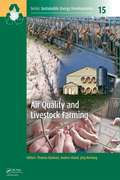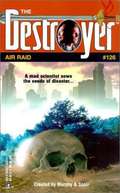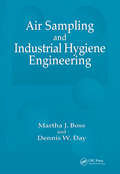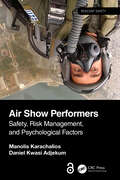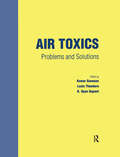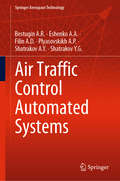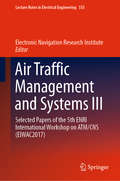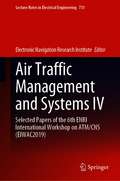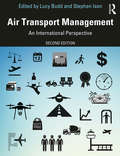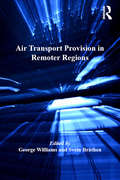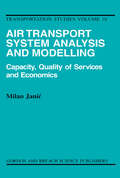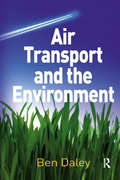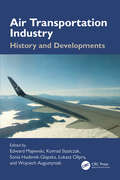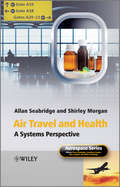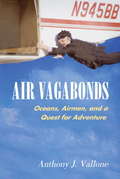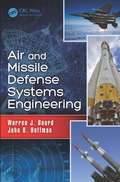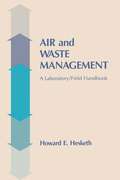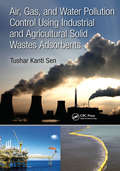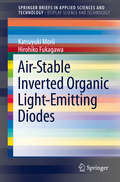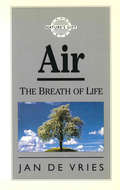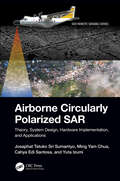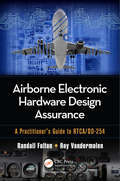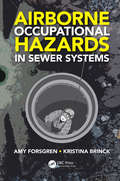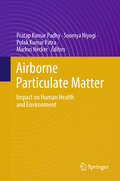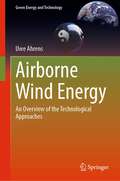- Table View
- List View
Air Quality and Livestock Farming (Sustainable Energy Developments)
by Thomas Banhazi Andres Aland Jörg HartungAir quality has a direct influence on health, welfare and production performance of livestock as the high concentrations of noxious gases, dust and airborne microorganisms are likely to reduce production efficiency and the general welfare of farm animals. Long term exposure to particulates in livestock buildings might also affect the respiratory health of farm workers. Dust in animal buildings contains many biologically active substances such as bacteria, fungi, endotoxins and residues of antibiotics (as a result of veterinary treatments) that are suspected to be hazardous to human health. Furthermore, air pollutants emitted from livestock buildings can reduce air, water and soil quality and can potentially undermine the health of nearby residents. Airborne emissions include ammonia, methane, nitrous oxide, particulates like dust and microorganisms. In addition, other potentially harmful substances such as heavy metals, antibiotic residues and components of disinfectants might be also emitted from livestock building that are potentially damaging to ecosystems. In this book, key aspects of agricultural air quality, such as monitoring, managing and reducing airborne pollutants in and around livestock facilities are reviewed. Features: addressing the raising awareness of the importance of optimal health and welfare for lifestock species with contributions from international specialists and researchers providing up-to-date information for professionals involved in modern animal producti This book will be useful for farming professionals, academics, students, policy makers, business leaders, regulatory bodies and agricultural consultants.
Air Raid (Destroyer, #126)
by Warren MurphyDON'T BREATHE THE AIR They are tiny, genetically engineered blue seeds that mature quickly into trees that literally suck all the oxygen out of the air. They're the earth-friendly but highly secretive Congress of Concerned Scientists, and now they've been snatched by its head, Dr. Hubert St. Clair. Having killed off all but one of his scientific team, he's leading Remo and Chiun on a chase through the proverbial forest. He's got enough seeds to choke off the world's oxygen supply, and the ability to create environmental disasters at will. Battling everything from acid rain to blistering heat to frigid cold, the Destroyer races to thwart double disaster in the Amazon rainforest: St. Clair is planting seeds like a maniac and a U.S. President prepares to nuke Brazil into oblivion.
Air Sampling and Industrial Hygiene Engineering
by Martha J. Boss Dennis W. DayWe know certain chemicals cause problems in the workplace. The issues now are: Where do they occur in the workplace? How can we best evaluate them? What are the procedures for dealing with them safely? Many books simply define the problem and tell you that you need a program. Air Sampling and Industrial Hygiene gives you a guide to air sampling protocols from start to finish. The book presents sampling technology updated with today's tools - such as microcircuitry and remote sensing. The authors emphasize an interdisciplinary approach to understanding how air monitoring can adequately report current environmental conditions associated with outdoor media, indoor remediation efforts, proximal equipment, interior line monitoring, and the interrelationship of ventilation parameters. In addition to providing the how-tos of sampling, this guide covers the basics of chemical risk assessment, biological assessment, engineering evaluation of mechanical system design criteria, and chemical or process engineering hazard assessments. It presents the information using text, text outlines, graphics, and pictures - including cross sections of instrumentation and side bars to elaborate on complex concepts.Faulty readings caused by poor sampling techniques can be very costly. This book provides the how-tos for making design engineering and on-site decisions as to instrumentation selection and scheduled usage. Air Sampling and Industrial Hygiene Engineering will allow you to complete the sampling process systematically and correctly from initial suspicions to the use of obtained results.
Air Show Performers: Safety, Risk Management and Psychological Factors (Resilient Safety)
by Manolis Karachalios Daniel Kwasi AdjekumAir shows are high-risk activities that must be conducted with careful thought towards the general public, spectators, and flying and nonflying participants to ensure that the activity is as safe as reasonably possible. The impromptu, ad hoc, unrehearsed or unplanned must never be attempted. This book offers a holistic overview of the state of safety, including safety cultural variables, safety risk parameters, and human performance factors, in the international air show community. This book aims to close the knowledge gap on safety management in air shows. It imparts to the aviation sector and other high-risk and high-performance industries the experience and knowledge that airshow performers have gained regarding risk assessment, psychological aspects, and mindfulness techniques used for safe and effective performances. The book highlights how resilient safety culture can change the air show community's mentality to deliver safer and more spectacular air show events and promotes the culture of excellence that the air show community is wedded to. The reader will obtain a thorough understanding of safety issues in air shows. Air Show Performers: Safety, Risk Management, and Psychological Factors is a critical read for professionals within the international air show community including nonflying participants. Its appeal extends to practitioners in aviation, health and safety and events management.“[…] For sure, this book will become a reference and a source of inspiration for future generations of Display Pilots.”Jacques Bothelin, French Aerobatic Jet Team Leader, Honorary Board Member European Airshow CouncilManolis Karachalios was the Hellenic Air Force’s F-16 Demo Team “ZEUS” Display Pilot for the 2010–2012 display seasons. Dr. Karachalios holds a Master of Business Administration (MBA) in Aviation Management from Coventry University, and a Doctor of Philosophy (PhD) in Aerospace Sciences from the University of North Dakota focusing on air show safety and development.Daniel Kwasi Adjekum has over 25 years of experience in aviation as a former Ghana Air Force squadron commander, command pilot, and air display safety director. He was also an airline pilot and is currently an aviation safety consultant and professor of aviation. He is an Internationally recognized aviation safety subject-matter expert and an International Air Transport Association (IATA) certified Safety Management Systems (SMS) implementation and control expert.
Air Toxics: Problems and Solutions
by Kumar GanesanThis timely new workbook is the result of a year-long effort by a group of university professors who first met at Montana Tech during the summer of 1994 for a college faculty workshop. The workshop was funded by the National Science Foundation's support for those faculty developing courses in the newly emerging field of air toxics. Part I of the book contains over 100 problems dealing with a variety of topics in this area. Part II provides detailed solutions. The problems and solutions provided will become a useful resource for the training of engineers and scientists who are or soon will be working in the field.
Air Traffic Control Automated Systems (Springer Aerospace Technology)
by Shatrakov A.Y. Shatrakov Y.G. Bestugin A.R. Eshenko A.A. Filin A.D. Plyasovskikh A.P.This book highlights operation principles for Air Traffic Control Automated Systems (ATCAS), new scientific directions in design and application of dispatching training simulators and parameters of ATCAS radio equipment items for aircraft positioning. This book is designed for specialists in air traffic control and navigation at a professional and scientific level. The following topics are also included in this book: personnel actions in emergency, including such unforeseen circumstances as communication failure, airplane wandering off course, unrecognized aircraft appearance in the air traffic service zone, aerial target interception, fuel draining, airborne collision avoidance system (ACAS) alarm, emergency stacking and volcanic ash cloud straight ahead.
Air Traffic Management and Systems III: Selected Papers of the 5th ENRI International Workshop on ATM/CNS (EIWAC2017) (Lecture Notes in Electrical Engineering #555)
by Electronic Navigation Research InstituteThis proceedings provides novel concepts and techniques for air traffic management (ATM) and communications, navigation, and surveillance (CNS) systems. The volume consists of selected papers from the 5th ENRI International Workshop on ATM/CNS (EIWAC2017) held in Tokyo in November 2017, the theme of which was “Drafting Future Skies”. Included are key topics to realize safer and more efficient skies in the future, linked to the integrated conference theme consisting of long-term visions based on presentations from various fields. The proceedings is dedicated not only to researchers, academicians, and university students, but also to engineers in the industry, air navigation service providers (ANSPs), and regulators of aviation.
Air Traffic Management and Systems IV: Selected Papers of the 6th ENRI International Workshop on ATM/CNS (EIWAC2019) (Lecture Notes in Electrical Engineering #731)
by Electronic Navigation Research InstituteThis book provides novel concepts and techniques for air traffic management (ATM) and communications, navigation, and surveillance (CNS) systems. The book consists of selected papers from the 6th ENRI International Workshop on ATM/CNS (EIWAC2019) held in Tokyo in October 2019, the theme of which was “Exploring Ideas for World Aviation Challenges”. Included are key topics to realize safer and more efficient skies in the future, linked to the integrated conference theme consisting of long-term visions based on presentations from various fields. The book is dedicated not only to researchers, academicians, and university students, but also to engineers in the industry, air navigation service providers (ANSPs), and regulators of aviation.
Air Transport Management: An International Perspective
by Lucy BuddAir Transport Management: An International Perspective provides in-depth instruction in the diverse and dynamic area of commercial air transport management. The 2nd edition has been extensively revised and updated to reflect the latest developments in the sector. The textbook includes both introductory reference material and more advanced content so as to provide a solid foundation in the core principles and practices of air transport management. This 2nd edition includes a new chapter on airline regulation and deregulation and new dedicated chapters focusing on aviation safety and aviation security. Four new contributors bring additional insights and expertise to the book. The 2nd edition retains many of the key features of the 1st edition, including: • A clearly structured topic-based approach that provides information on key air transport management issues including: aviation law, economics; airport and airline management; finance; environmental impacts, human resource management; and marketing; • Chapters authored by leading air transport academics and practitioners worldwide which provide an international perspective; • Learning objectives and key points which provide a framework for learning; • Boxed case studies and examples in each chapter; • Keyword definitions and stop and think boxes to prompt reflection and aid understanding of key terms and concepts. Designed for undergraduate and postgraduate students studying aviation and business management degree programmes and industry practitioners seeking to expand their knowledge base, the book provides a single point of reference to the key legal, regulatory, strategic and operational concepts and processes that shape the form and function of the world’s commercial air transport industry.
Air Transport Provision in Remoter Regions
by Svein BråthenThis book stems from a series of biennial conferences devoted to issues affecting air-transport provision in remoter regions that have been organized by the Centre for Air Transport in Remoter Regions at Cranfield University. The primary aim of the conferences has been to provide an opportunity for those responsible for operating, managing, regulating and financing air transport services and associated infrastructure in these areas to be informed of the latest best-practice initiatives, to contrast different policy approaches and to debate potential solutions to perennial problems. Remoter regions has been a neglected area of air transport, as much of the focus of public and media attention is on the larger airlines, airports and aircraft. While the number of large airports in the world is in the hundreds, there are many thousands of smaller airports providing communities all over the globe with vital air links. More often than not these services and the airports to which they are operated are loss making and require subsidies to sustain them. There are therefore many more interested parties involved in both providing and deciding issues relating to the provision of air transport in these situations, most especially central, regional and local governments who are charged with financing these activities. The book contains 17 chapters from experts in remote-region air transport, within the following 5 sections: - Key economic and socio-economic issues - Subvention mechanisms - Route development initiatives - Infrastructure provision - Issues affecting the provision of air services in remoter regions.
Air Transport System Analysis and Modelling (Transportation Studies)
by Milan JanicPresenting a comprehensive coverage, Air Transport System Analysis and Modelling is a unique text dealing with the analysis and modelling of the processes and operations carried out in all three parts of the air transport system, namely, airports, air traffic control and airlines. Seen from a planners point of view, this book provides insights into
Air Transport and the Environment
by Ben DaleyAir Transport and the Environment provides an overview of the main issues relating to aviation environmental impacts. It explains the challenge facing policymakers in terms of sustainable development, focusing on the importance of balancing the industry's economic, social and environmental costs and benefits, both for people living now and for future generations. Individual chapters review the current scientific understanding of the main aviation environmental impacts: climate change, local air pollution and aircraft noise. Various responses to those issues are also considered, including a range of policy options based on regulatory, market-based and voluntary approaches. Key concepts such as environmental capacity, radiative forcing and carbon offsetting are explained. In addition, the book emphasises the main implications of aviation environmental issues for policymakers and for the management of the air transport industry. Debates about the environmental impacts of flying often generate strongly polarised reactions, yet this book adopts a constructive approach to the subject and attempts to present the environmental issues in a clear, straightforward manner. It aims to provide a policy-relevant synthesis of a wide range of perspectives rather than advocating one particular viewpoint. Yet the central purpose of this book is to bring the sustainable development challenge facing the air transport industry to the fore, and so to inform effective policy responses. Air transport plays a critical role in supporting economies and societies that are increasingly interconnected by globalisation; this book presents the view that the vital economic and social benefits of the air transport industry should not be lost - and in fact could be distributed far more widely and equitably - but that the environmental impacts of air transport nevertheless require urgent and effective management. Air Transport and the Environment has been written primarily for professionals in the air transport industry, policymakers and regulators. It is also intended for use by academic researchers, students and others who are interested in the complex relationship between air transport and the environment.
Air Transportation Industry: History and Developments
by Edward Majewski Konrad Stasiczak Sonia Huderek-Glapska Łukasz Olipra Wojciech AugustyniakAir Transportation Industry considers the influence of political, legal, economic, social, and technological factors on the developments in the industry. It provides a brief historical background of the air transport industry, the determinants of the changes in the airline business, and adaptation processes that resulted in the evolution of business models and structural changes in the industry.Utilizing a unique database containing the characteristics of more than 16,000 air carriers worldwide, the book discusses key findings related to changes in the transport capacity of airlines operating at different points in time, including the length of the lifecycle and reasons for termination of activity, types, and geographical scope of operations. It also explores the impacts of global and regional-scale legal regulations.The book will interest air transportation and airport operations researchers. It can also serve as a reference for management and operations transportation students in logistics, air transportation, and economics courses.
Air Travel and Health
by Allan Seabridge Shirley MorganProviding a detailed examination of the issues that affect the long term health of aircrew, cabin crew and passengers, Air Travel and Health offers guidance to engineers designing aircraft in the difficult field of legislation and product liability. Examining the facts, anecdotes and myths associated with health and travel, Seabridge and Morgan draw balanced conclusions on which the aircraft operations and design communities can act to provide cost-effective solutions. The authors present a useful reference for aircrew, regulatory authorities, engineers and managers within the aerospace industry, and medical and human factor specialists, as well as an informative resource for undergraduate and graduate students.
Air Vagabonds
by Anthony J. ValloneAir Vagabonds is the story of the amazing, true (mis)adventures of a band of rogues piloting aircraft alone into exotic and deadly destinations.In the late 1970s and through the 1980s the demand for light aircraft eclipsed anything seen before or since. This created the need for a small air force of pilots--ferry pilots--willing to fly thousands of planes to clients in every corner of the globe. Long-range solo flying is not for everyone, and it attracted a cast of eccentric, unforgettable mavericks who flew from one misadventure to the next, battling storms, desert winds, aircraft malfunctions, primitive navigational aids, loneliness, chemical imbalances, and dangerous Third World politics. Some carried on international scams and love affairs, some were lost at sea, some imprisoned by African despots. They're all here, described with humor and high drama by one of their own, a survivor with phenomenal recall, a knack for distinguishing character from bluster, and a great ear for dialogue and aviation lore.
Air and Missile Defense Systems Engineering
by Warren J. BoordAir and Missile Defense Systems Engineering fills a need for those seeking insight into the design procedures of the air and missile defense system engineering process. Specifically aimed at policy planners, engineers, researchers, and consultants, it presents a balanced approach to negating a target in both natural and electronic attack environmen
Air and Waste Management: A Laboratory and Field Handbook
by Howard D. HeskethThis manual will serve a useful function in training and giving experience to environmental scientists at all levels. Included in this manual are explanatory materials, exercises and experiments. These are intended as training guides. The users of this manual will find it possible to use simple equipment and naturally occurring events to construct some of the needed equipment but may also find it necessary to use commercially available equipment with some of the procedures.
Air, Gas, and Water Pollution Control Using Industrial and Agricultural Solid Wastes Adsorbents
by Tushar SenAir and water pollution occurs when toxic pollutants of varying kinds (organic, inorganic, radioactive and so on) are directly or indirectly discharged into the environment without adequate treatment to remove these potential pollutants. There are a total of 13 book chapters in three sections contributed by significant number of expert authors around the world, aiming to provide scientific knowledge and up-to-date development of various solid wastes based cost-effective adsorbent materials and its sustainable application in the removal of contaminates/pollutants from air, gas and water. This book is useful for the professions, practicing engineers, scientists, researchers, academics and undergraduate and post-graduate students’ interest on this specific area. Key Features: • Exclusive compilation of information on use of industrial and agricultural waste based adsorbents for air and water pollution abatement. • Explores utilization of industrial solid wastes in adsorptive purification and agricultural and agricultural by-products in separation and purification. • Discusses cost-effective solid wastes based emerging adsorbents. • Alternative adsorbents in the removal of a wide range of contaminants and pollutants from water is proposed. • Includes performance of unit operations in waste effluents treatment.
Air-Stable Inverted Organic Light-Emitting Diodes (SpringerBriefs in Applied Sciences and Technology)
by Katsuyuki Morii Hirohiko FukagawaThis concise volume provides an introduction to the working principles, design, and construction of air-stable inverted organic light-emitting diodes (OLEDs), which lead to the realization of practical flexible electronics. The first part of the book reviews the history of the three generations of inverted OLEDs: hybrid organic inorganic light-emitting diodes (HOILEDs), metal oxides and organic electron injection layer, describing the materials, fabrication techniques, device structure, applications, and technological challenges involved in each case. The second part of the book focuses on the carrier injection mechanism in OLEDs.The book will be of interest to students and researchers working on organic optoelectronics.
Air: The Breath of Life (Nature's Gift Ser.)
by Jan de VriesPollution is an ever-growing threat to our planet and manifests itself most dramatically in its impact on the natural environment which surrounds us. But just as trees are dying daily because of environmental pollution, so too are humans suffering. Air pollution has led directly to an increase in asthma, bronchitis and other related respitory complaints. In Air: The Breath of Life, Jan de Vries calls upon his vast experience in dealing with respiratory problems to guide his readers on how best to assist our own immune system in combating the worst effects of pollution.
Airborne Circularly Polarized SAR: Theory, System Design, Hardware Implementation, and Applications (SAR Remote Sensing)
by Josaphat Tetuko Sri Sumantyo Ming Yam Chua Cahya Edi Santosa Yuta IzumiA comprehensive resource on airborne synthetic aperture radar (SAR) systems, Airborne Circularly Polarized SAR explains the theory, system design, hardware and software, and applications of airborne circularly polarized SAR in environmental monitoring and other uses. Readers learn how to build the hardware and software of circularly polarized SAR, the antenna system, and how to generate point target responses and images using the range doppler algorithm (RDA) from raw signal data. The book discusses applications and analyzing techniques using a circularly polarized SAR system and image processing. Images and MATLAB® codes are provided to help professionals and researchers with their applications and future studies. Features 1. Provides the theory of circularly polarized wave and polarimetry related to system design, scattering analysis, polarimetric SAR, and applications in microwave remote sensing. 2. Explains the real radio frequency (RF) system and the original antenna, including circuit explanation and know-how of measurement technique to adjust to the required parameter in system design. 3. Discusses the technique of ground test and flight mission to calibrate and validate the performance of airborne circularly polarized SAR. 4. Highlights image signal processing with MATLAB codes and how to obtain a single look complex (SLC) image for further applications. 5. Includes several applications of airborne circularly polarized SAR from international leading experts. This book is beneficial to professionals, researchers, academics, and graduate students from disciplines such as Electronic Engineering; Radar Systems; Aerospace Engineering; Signal Processing; Image Processing; Environmental Remote Sensing.
Airborne Electronic Hardware Design Assurance: A Practitioner's Guide to RTCA/DO-254
by Randall Fulton Roy VandermolenWritten by a Federal Aviation Administration (FAA) consultant designated engineering representative (DER) and an electronics hardware design engineer who together taught the DO-254 class at the Radio Technical Commission for Aeronautics, Inc. (RTCA) in Washington, District of Columbia, USA, Airborne Electronic Hardware Design Assurance: A Practitioner's Guide to RTCA/DO-254 is a testimony to the lessons learned and wisdom gained from many years of first-hand experience in the design, verification, and approval of airborne electronic hardware. This practical guide to the use of RTCA/DO-254 in the development of airborne electronic hardware for safety critical airborne applications: Describes how to optimize engineering processes and practices to harmonize with DO-254 Addresses the single most problematic aspect of engineering and compliance to DO-254—poorly written requirements Includes a tutorial on how to write requirements that will minimize the cost and effort of electronic design and verification Discusses the common pitfalls encountered by practitioners of DO-254, along with how those pitfalls occur and what can be done about them Settles the ongoing debate and misconceptions about the true definition of a derived requirement Promotes embracing DO-254 as the best means to achieve compliance to it, as well as the best path to high-quality electronic hardware Airborne Electronic Hardware Design Assurance: A Practitioner's Guide to RTCA/DO-254 offers real-world insight into RTCA/DO-254 and how its objectives can be satisfied. It provides engineers with valuable information that can be applied to any project to make compliance to DO-254 as easy and problem-free as possible.
Airborne Occupational Hazards in Sewer Systems
by Amy Forsgren Kristina BrinckSewer systems fall into the category "out of sight, out of mind" – they seldom excite interest. But when things go wrong with the air in the sewer system, they go very wrong. Consequences can be dramatic and devastating: sewer workers killed instantly by poisonous gas when they lift a sewer lid, or entire suburban blocks levelled by explosions. This book describes the atmospheric dangers commonly found in the sewer system. It provides easily-understood explanations of the science behind the hazards, combined with real-life examples of when things went dramatically wrong.
Airborne Particulate Matter: Impact on Human Health and Environment
by Markus Hecker Pratap Kumar Padhy Soumya Niyogi Pulak Kumar PatraParticulate matter (PM) in the ambient air is a key indicator of air pollution. It can be suspended over long time and travel over a long distance in the atmosphere. It can cause a wide range of diseases that lead to a significant reduction of human life. Because of the potent role of PM and its associated pollutants, detailed knowledge of their effects on the environment in general, and human health in particular, is of primary importance. This book provides an in-depth overview of monitoring of airborne particulates and their sources and transport. The dynamics of nutrients, intake pathways of particulates by human body and other components of environment, and their possible health hazards and effects at different levels and at various organs are discussed. With contributions from well-known experts from diverse research fields, including medical and public health science professions, this book provides an exhaustive information on the health risks of air pollution and explores its control and mitigation strategies. In addition to providing a scientific basis for particulate air pollution, this book will also help readers, researchers and public health professionals to appreciate the environmental determinants of public health and apply research evidence for improving the quality of life. This will also delineate future research initiatives and policy actions needed with more stringent strategies for protecting the environment in general and human health in particular from PM at local, regional, and global levels.
Airborne Wind Energy: An Overview of the Technological Approaches (Green Energy and Technology)
by Uwe AhrensThis book shows possible solutions to how a profitable energy supply can be implemented with almost no population resistance. Worldwide, more than 80 % of our energy needs are still covered by fossil fuels. Under these circumstances, can climate change still be stopped? Essential technologies for usage of wind energy with an emphasis on high-altitude wind utilization are presented. Airborne wind energy is one of the most promising technologies to enable a renewable energy turnaround in an economical way. The main problem of conventional renewable energy is the insufficient availability. To ensure a 100 % supply of renewable energy, enormous and very expensive storage capacities would have to be built up. How we can cover our entire energy needs (electricity, mobility and heat) in the future without fossil fuels, without risking the competitiveness of our economy, is shown in this book.
